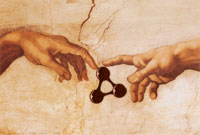We're still using Protege, but this time working with the new ALPHA version and getting deeper into concepts.
Get the Flash Player to see this player.
We're still using Protege, but this time working with the new ALPHA version and getting deeper into concepts.
Get the Flash Player to see this player.
Published 16 years ago by Cody Burleson
 Today we reach an important milestone in this series. We are crossing a great divide between familiar technologies such as XML, Unicode, URI, and RDF to the Web Ontology Language (OWL). This, my friends, is where things really start to get interesting because this is the point where the Semantic Web vision really starts to take form. Today, we present a screencast exhibiting Protégé — a free, open source ontology editor and knowledge-base framework developed by Stanford Center for Biomedical Informatics Research at the Stanford University School of Medicine. In this screencast, we show you how to develop a useful Semantic Web-ready application in just minutes. You will learn how to model a very simple ontology in OWL (the Web Ontology Language).
Today we reach an important milestone in this series. We are crossing a great divide between familiar technologies such as XML, Unicode, URI, and RDF to the Web Ontology Language (OWL). This, my friends, is where things really start to get interesting because this is the point where the Semantic Web vision really starts to take form. Today, we present a screencast exhibiting Protégé — a free, open source ontology editor and knowledge-base framework developed by Stanford Center for Biomedical Informatics Research at the Stanford University School of Medicine. In this screencast, we show you how to develop a useful Semantic Web-ready application in just minutes. You will learn how to model a very simple ontology in OWL (the Web Ontology Language).
 In Part 2 of this series we reviewed Unicode, URI, and XML - three foundational technologies that permeate the existing Web and that are especially relevant to the emerging Semantic Web. We will put all three to use as we take our next step up the Semantic Web layer cake in a review of the Resource Description Framework (RDF). At the same time, we will be taking the visual RDF/OWL editor, Altova SemanticWorks, for a test drive. Since I will be using this tool for the very first time, you can expect an honest review that is rich with screenshots. If you do not already have the software, you may wish to download the trial version now so you can follow along.
In Part 2 of this series we reviewed Unicode, URI, and XML - three foundational technologies that permeate the existing Web and that are especially relevant to the emerging Semantic Web. We will put all three to use as we take our next step up the Semantic Web layer cake in a review of the Resource Description Framework (RDF). At the same time, we will be taking the visual RDF/OWL editor, Altova SemanticWorks, for a test drive. Since I will be using this tool for the very first time, you can expect an honest review that is rich with screenshots. If you do not already have the software, you may wish to download the trial version now so you can follow along.
Published 16 years ago by Cody Burleson
 In Part 1 of this series, we introduced the Semantic Web vision set forth by Tim Berners-Lee. We also took a look at the famous layer cake diagram illustrating key technologies that make it possible. This week, we'll be munching around the bottom of the layer cake with a few important points about Unicode, URI, and XML. Below, you may notice that we are presenting a slightly different illustration of the layer cake than last week. The intent is not to confuse you, but rather to point out that there are a variety of interpretations floating around the Web.
In Part 1 of this series, we introduced the Semantic Web vision set forth by Tim Berners-Lee. We also took a look at the famous layer cake diagram illustrating key technologies that make it possible. This week, we'll be munching around the bottom of the layer cake with a few important points about Unicode, URI, and XML. Below, you may notice that we are presenting a slightly different illustration of the layer cake than last week. The intent is not to confuse you, but rather to point out that there are a variety of interpretations floating around the Web.
Continue reading Introduction to the Semantic Web Vision and Technologies - Part 2 - Foundations
Published 16 years ago by Cody Burleson
 The World Wide Web has long been evolving towards the vision of the Semantic Web — an extension of the existing web through which machines are better able to interoperate and work on our behalf. It promises to infuse the Internet with a combination of metadata, structure, and various technologies so that machines can derive meaning from information, make more intelligent choices, and complete tasks with reduced human intervention. It is a dramatic vision that stands to transform the existing Web in devastatingly powerful ways.
The World Wide Web has long been evolving towards the vision of the Semantic Web — an extension of the existing web through which machines are better able to interoperate and work on our behalf. It promises to infuse the Internet with a combination of metadata, structure, and various technologies so that machines can derive meaning from information, make more intelligent choices, and complete tasks with reduced human intervention. It is a dramatic vision that stands to transform the existing Web in devastatingly powerful ways.
Continue reading Introduction to the Semantic Web Vision and Technologies - Part 1 - Overview
Page 1 of 1
Most Recent Blog Entries
Recently Commented Blog Entries